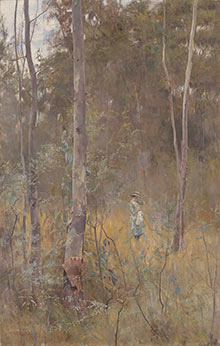The Royal Academy of Arts, in collaboration with the National Gallery of Australia, are currently showing the exhibition Australia in London. Marking the first major survey of Australian art in the UK for 50 years, 'this exhibition spans more than 200 years from 1800 to the present day and seeks to uncover the fascinating social and cultural evolution of a nation through its art.'
The Guardian recently asked several Australian writers to pick their favourite artworks from the exhibition, and I was honoured to be included in their number. My selection of Frederick McCubbin's 'Lost' is below. The full article, with responses from writers such as Christos Tsiolkas, Tim Winton, MJ Hyland and Chloe Hooper can be read here.
Frederick McCubbin's
'Lost' (1886)
I first saw Frederick McCubbin's Lost when I was a child, no older than the girl in the painting. It frightened me. As the daughter of two country-born parents, I had grown up knowing the bush and its dangers. I knew what it was like to walk in the dry air, blistered grass cracking underfoot, the horizon disappearing behind stretches of saplings and the smell of eucalypt lifting with every footfall. I knew how thirsty you could become when the shadows lay thin on the ground, and how the scrub could rise around you – grey, scorched and watching – until you were afraid you would never get out. "If you become lost," my parents would tell me, "don't go anywhere. Stay in the shade. If you wander, it will be difficult to find you." When I first saw McCubbin's painting of a young girl, alone and straying, I feared for her. The artist's impression of the bush captured, in its detail of peeling bark and yellowed grass, the menace I sensed from this landscape as a child. McCubbin captures its beauty – its extraordinary quality of light – but also its deadliness. The little girl is insignificant in the bush's expanse. The sky is disappearing.
Lost is said to be inspired by the 1885 case of Clara Crosbie, a young girl who was miraculously found alive in dense bush after having gone missing three weeks earlier. I'm drawn to McCubbin's paintings for the way they suggest a deeper narrative. I see the Australia I know: lyrical, singular and unsettling.Read the full article here.
